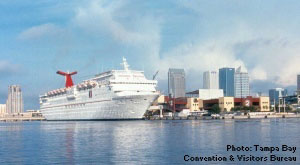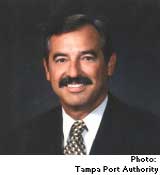
|
|||
|
Tampa Bay Fuels Region's Economy by Victoria Parsons |
|||
|
The numbers are impressive. The three ports that border Tampa Bay support 130,000 jobs and contribute more than $15 billion per year to the local economy. The largest by far, the Port of Tampa comprises nearly half of all sea borne commerce in the state. But that's just skimming the surface of the impact Tampa Bay has on the economy of the region that bears its name.
ð Tourism is the kingfish, contributing a whopping $50 billion to the state economy. While sun - drenched beaches are the big draw, millions of nature lovers come to Florida to walk, canoe and kayak on the wild side, exploring estuaries like Tampa Bay. According to a recent state study, more people travel to Florida to view wildlife than any other state. Florida residents alone spent $1.2 billion on equipment and traveling for wildlife viewing in 2001. ð The marine industry has a statewide economic output of over $14 billion and supports more than 180,000 jobs. In Pinellas County, for example, 259 businesses are marine related, with an annual economic impact of nearly $37 million. ð Recreational fishing had a $6 billion economic impact in 1996. The most recent comprehensive statistics available show that nearly three million anglers help to support 81,815 jobs. ð The economic impact of commercial seafood landings in Florida is $440 million, which supports nearly 10,000 jobs. Even the piers in Tampa Bay pull in more than just fish. A 2000 study indicates that public marine fishing piers in Florida each generate an annual economic impact of about $1.8 million, with public boat ramps adding another $1.4 million to the economy. And then there's waterfront real estate. While data on bayfront homes is a little difficult to come by, Hillsborough County collects about 15% of its total ad valorem taxes from all waterfront homes - even though they only comprise about 8% of the total number of homes. Tampa Bay also supports a booming research community that has helped make it one of the best studied estuaries in the world. More than 800 scientists work in what has become the largest marine research complex in the Southeast near downtown St. Petersburg (see related story page 4). And it would be impossible to quantify the "wow" effect that Tampa Bay has on visitors. "Talk about the bay - man alive! We had a site selection team in St. Petersburg for the Grand Prix races and we were watching the race, looking out over the bay, thinking 'This is the Monaco of the South," says attorney Rhea Law, chairman of the Tampa Bay Partnership, which leads economic development efforts for the region. The importance of ports
While cruise ships are more visible, the vast majority of ships that call on Tampa Bay ports carry decidedly unromantic cargo - petroleum and coal in, phosphate and other fertilizer products out. Without those cargos, however, the region would come to a screeching halt. Experts estimate that Tampa Bay can store about a week's worth of petroleum products and coal, including jet fuel for airports across Central Florida. Jobs in industries ranging from phosphate to steel fabrication would be lost if raw materials were suddenly not available. "We could truck in gasoline for cars and coal for our electric plants, but we'd sure feel the impact," Williamson said. The 12th largest port in the nation, Tampa is looking to the future and emphasizing diversity, including the cruise ship terminals that now generate about 20% of port revenue. The port also is building partnerships with local businesses to attract containerized cargo. "We went to the Committee of 100 and the Executive Shippers Council to identify businesses that bring in containerized cargo," Williamson said. "Rooms to Go brings in 10,000 containers a year, plus we have Ace Hardware, Publix, Vigo (Progressive Foods), Babcock Furniture and PepsiCo. When you add it all up, we'll bring 400,000 containers into this community through Miami, Savannah and Charleston." Council members are working with the steamship lines they currently use, asking them to provide service to Tampa. "So far about 14 international companies have responded to our request for expression of interest and we're in the process of working through them," he said. "It makes much more sense for us to find a partner than to build the infrastructure ourselves. They have the expertise and the credibility so we'll have a better chance of success." From a business perspective, transportation by ship is much less expensive - and often faster, depending upon where cargo is coming from. With products manufactured in Mexico, the difference can be dramatic. DaimlerChrysler, for instance, slashed the time it takes to ship PT Cruisers assembled in a plant near Mexico City to Tampa. "It was taking them 52 days to get them from Mexico to Tampa by train, via St. Louis and Memphis," Williamson said. "Now it's just 44 hours from Mexico to a Tampa showroom." Strategic location promises continued growth Tampa Bay offers a strategic location for business, particularly as trade with Latin America continues to grow. Already billed as the "NAFTA superhighway," Tampa Bay is actually closer to some key regions - including Havana and the Panama Canal - than the ports of Miami or Fort Lauderdale.
"The west coast ports are much more expensive and less profitable for steamships because of the competition," he says. "We'll never be Los Angeles, but we can be a good niche port for containers." Just south of the Manatee County line, Port Manatee also is growing with a $53 million expansion that is expected to double port capacity and revenue. "We'll invest more than $100 million between 1996 and the end of 2004," says David McDonald, port director. Construction on the most recent project actually began three years ago with a $6 million seagrass mitigation effort that allows the port to double its berthing capacity. Construction began in February on a new $9 million dock at Berth 5 and a $32 million dredging project that expands the port's entrance and turning basin as well as deepens it to 40 feet. Construction is continuing on Berth 12, a 1500-foot dock where a new warehouse with dry and chilled space and a facility to serve a cruise ferry and containerized "ro-ro" - boxes that roll on and off ships -- are on the drawing board. Much of the growth at Port Manatee is driven by the port's focus on working with tenants, McDonald said. DelMonte Fresh Produce first began operations at Port Manatee in 1989; now it is the company's second-largest U.S. port facility, behind Camden, N.J. serving the northeastern U.S. "DelMonte has been a marquis tenant for us, and their success lends credibility to the port," he said. "They've put a magnifying glass on our geographic advantages." Up to six ships per week, laden with bananas, pineapples and melons, call at Port Manatee where they are loaded onto thousands of refrigerated trucks and sent to grocery stores across the country. Tropicana Products, a long-time Bradenton company that's now part of PepsiCo, has made Port Manatee the nation's leading importer of frozen concentrated orange juice and the nation's leading export location for citrus juices and beverages. More than a million cruise ship passengers have sailed from Port Manatee since the Regal Empress began service in 1992. Boosting business across the region Ports clearly provide jobs for thousands of people, but they also help businesses that are less apparent. Manufacturers and retailers across the region depend on ports to transport products cost-effectively. Cruise ship passengers also boost local businesses, from hotels and restaurants to food distributors and florists. That impact is particularly clear in St. Petersburg where a cruise ship task force includes downtown businesses and the merchant's association. "The goal is to get both port-of-call and home-based operations," said Capt. Michael Perez, port director. Over the short term, the 450-foot, 2000-passenger Spirit of St. Petersburg is expected to set sail later this summer on day cruises. Basin depths - currently at 24 feet - make it difficult for the port to attract cruise operations like those in Tampa and Port Manatee, but port officials are highlighting downtown St. Petersburg as a port of call for several cruise lines. "As a port of call, we could immediately bring the ship in, anchor in deep water off The Pier and tender passengers in on smaller boats, the way they do in Key West," Perez said. "It would be an ideal stop for ships home-ported in Galveston and New Orleans and they would arrive in the middle of the week so 2000 to 4000 passengers could become customers for downtown businesses, museums and restaurants on what is normally a slow day." Over the long term, Perez is hopeful that the Army Corps of Engineers (see related story Running Out Of Room?) will authorize additional dredging so the port's basin is a uniform 34 feet deep. "That will handle any cruise ship that fits under the Sunshine Skyway Bridge," he said. From the very beginning, Tampa Bay has served as economic engine for the region and brings business and residents together to work toward common goals. "We have achieved a brand for Tampa Bay," says Law. "The thing that brings it all together is this big body of water."
|
|||
|
|
|||
 Although the dollars generated by other activities are harder to count, they likely exceed the ports' impact, particularly when combined. While local figures aren't readily available, Tampa Bay generates a good share of statewide dollars:
Although the dollars generated by other activities are harder to count, they likely exceed the ports' impact, particularly when combined. While local figures aren't readily available, Tampa Bay generates a good share of statewide dollars: Even though ports have a regional economic impact that rivals the state-wide impact of the citrus industry, many people still don't realize that more ships cross Tampa Bay than bridges. "Outside the maritime community, maybe 20% of residents have any idea that we're here," says George Williamson, director of the Tampa Port Authority. "And then they think we're cruise ships and Channelside because that's what put a face on the port."
Even though ports have a regional economic impact that rivals the state-wide impact of the citrus industry, many people still don't realize that more ships cross Tampa Bay than bridges. "Outside the maritime community, maybe 20% of residents have any idea that we're here," says George Williamson, director of the Tampa Port Authority. "And then they think we're cruise ships and Channelside because that's what put a face on the port." "Havana is almost due south of Key West, so ships leaving Miami have to travel much further west," Williamson notes. Labor disputes at California ports last year have pushed steamship companies to look for alternatives, he adds, and Tampa Bay ports are likely to win new service from Asia via the Panama Canal.
"Havana is almost due south of Key West, so ships leaving Miami have to travel much further west," Williamson notes. Labor disputes at California ports last year have pushed steamship companies to look for alternatives, he adds, and Tampa Bay ports are likely to win new service from Asia via the Panama Canal.